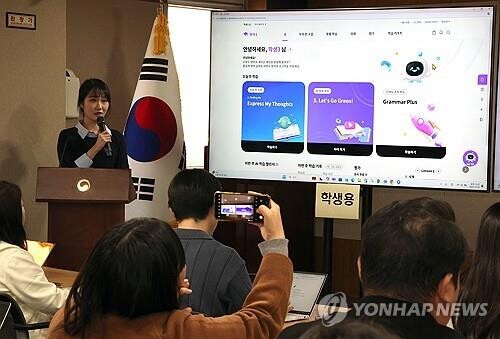*Editor’s note: K-VIBE invites experts from various K-culture sectors to share their extraordinary discovery about the Korean culture.
Matthew Lim's AI Innovation Story: Revolutionary Shift in Education
By Matthew Lim, AI expert and director of the Korean Association of AI Management (Former Head of Digital Strategy Research at Shinhan DS)

As private education spending in South Korea surpasses ₩27 trillion in 2024, concerns over educational disparities have grown. Families with monthly incomes exceeding ₩8 million spent an average of ₩671,000 on private education, 3.7 times higher than the ₩183,000 spent by families earning less than ₩3 million. Regional disparities are also stark, with Seoul families averaging ₩628,000 per month compared to ₩289,000 in rural areas.
Amid these challenges, the education sector is embracing a transformative innovation: AI Digital Textbooks (AIDT).
In 2025, South Korea will introduce AIDTs for third and fourth graders in elementary school, and first-year students in middle and high school, covering subjects like English, mathematics, and information technology. AIDTs are more than digitalized textbooks; they leverage artificial intelligence to analyze individual learning data and provide personalized educational experiences.
Key features of AIDTs include:
English Learning: AIDTs use voice recognition to analyze students’ pronunciation and intonation in real time, offering tailored feedback.
Mathematics: These tools assess problem-solving patterns to recommend supplementary learning material, akin to having a personal tutor for each student.
 |
| ▲ South Korea's Deputy Prime Minister and Minister of Education Lee Ju-ho holds a discussion session titled "Tea Talk Together" with frontline teachers at the Government Complex Sejong on December 5, 2024, in this photo provided by the education ministry The session focused on the practical implementation and effective utilization of AI Digital Textbooks (AIDTs). (Ministry of Education) |
Despite its promise, the rollout of AIDTs faces significant hurdles:
Budget Concerns: The original ₩170 billion budget for the initiative may balloon to ₩6 trillion, driven by the need for wireless internet infrastructure in schools. This financial strain could impact the pace and scale of the project.
Legal Status: AIDTs’ designation as “educational materials” rather than “textbooks” in a recently passed law has raised concerns. As educational materials, their use depends on the discretion of school principals, potentially exacerbating regional disparities. The Ministry of Education is considering administrative and financial support measures while seeking to challenge this designation.
Readiness of Schools: Many educators feel the rollout is premature. A survey by the Seoul Teachers’ Union revealed that 94% of respondents opposed the full-scale adoption of digital textbooks, citing inadequate preparation and training.
 |
| ▲ At a demonstration event for the final approved version of the AI Digital English Textbook held at the main conference room of the Ministry of Education in the Government Complex Sejong on December 2, 2024, an official explains interactive teaching methods and personalized learning approaches based on the core features of AI Digital Textbooks (AIDTs). (Yonhap) |
Despite ongoing challenges, the transformative potential of AI Digital Textbooks (AIDTs) is undeniable. A promising example can be found in Estonia, which pioneered digital education and, within 30 years of gaining independence, achieved top-tier results in the OECD's Programme for International Student Assessment (PISA), leading Europe in educational innovation.
To fully harness AIDTs' potential, several key tasks must be addressed:
Budget Planning and Execution: A realistic and efficient plan for securing and allocating funds is essential.
Legal and Systemic Support: Resolving legal uncertainties around AIDTs' status and ensuring systematic support for all schools wishing to adopt them.
Teacher Training: Comprehensive professional development programs for educators must be provided to ensure effective use.
Infrastructure Equity: Addressing disparities in school network infrastructure to create an environment where all schools can use AIDTs seamlessly.
The case of the North Jeolla Provincial Office of Education illustrates how these preparations can be implemented. The province has already equipped all third graders and above with smart devices, installed electronic blackboards, and established wireless networks. Such proactive measures provide a roadmap for other regions.
Central and local governments, along with schools, must work in harmony to overcome the current hurdles. With cohesive efforts, the difficulties related to funding, legal status, and infrastructure can be surmounted, paving the way for AIDTs to be effectively integrated into classrooms.
In the era of digital transformation, AIDTs are no longer an option but a necessity. While the initiative currently faces challenges in legal status and funding, overcoming these obstacles through administrative and financial support from the Ministry of Education can position South Korea as a global leader in education innovation.
More importantly, AIDTs hold the promise of addressing long-standing educational disparities. By creating an environment where every student, regardless of income level or location, can receive high-quality, personalized education, AIDTs embody the future of education.
Education is a long-term national strategy, and AIDTs represent the first step toward realizing the dream of equitable learning opportunities for all.
(C) Yonhap News Agency. All Rights Reserved



































